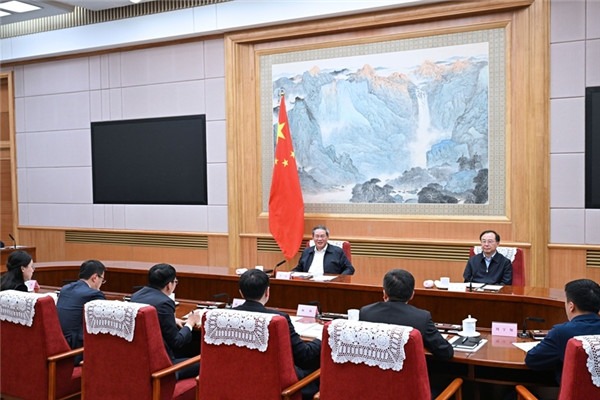Economic pain points not sign of balance sheet recession


Some analysts have recently expressed a view that China may face the risk of a balance sheet recession if its real estate bubble bursts. Such concerns, though reasonable, seem misplaced.
Amid international headwinds, China, which is also shouldering tasks of keeping domestic reforms, development and economic stability on a steady track, saw its GDP increase by 5.5 percent year-on-year in the first half — a recovery achieved with pressure in various areas.
First, inflation indicators have fallen significantly, while deflationary pressure has gradually increased. In June, the consumer price index reported zero growth year-on-year, and the producer price index fell 5.4 percent on a yearly basis — it has actually been in negative territory for nine consecutive months.
Second, increased unemployment rates are putting pressure on young job seekers. In June, the surveyed urban unemployment rate reached 5.2 percent, and that of those aged 16-24 stood at 21.3 percent, a peak in recent years.
Third, the three major economic drivers — consumption, investment and exports — have all fallen short of expectations. In June, total retail sales of consumer goods increased by 3.1 percent year-on-year, much lower than the 12.7 percent result in May. The cumulative year-on-year growth rate of fixed-asset investment was 3.8 percent, of which real estate investment growth remained negative for 14 consecutive months at — 7.9 percent. In terms of trade, the year-on-year growth rate of exports and imports in US dollar terms was-12.4 percent and — 6.8 percent, respectively.
Last but not least, financial indicators have been weak. Narrow money supply, or M1, which covers cash in circulation plus demand deposits, grew by merely 3.1 percent year-on-year in June, the lowest since January 2022.
These figures indeed reflect a relatively unstable basis for China's economic recovery. But a balance sheet recession? Not really.
A balance sheet recession is usually triggered by the bursting of an asset-price bubble, which China has not experienced so far. In Japan, it once stemmed from a decline in both real estate and stock prices. However, the basic elements leading to sharp price declines in China's real estate and stock markets haven't surfaced. Real estate markets, especially in major cities nationwide, still show strong real demand, while the current policy of limiting loans and purchases has not been completely removed. If more innovative measures are put in place to address the housing demand of groups such as migrant workers in third- and fourth-tier cities, the pressure of oversupply in the real estate market can be eased.
For example, local governments can purchase commercial housing from developers through a cost markup and convert them into low-cost or public rental housing, which can not only reduce the inventory of commercial housing, but also meet the housing needs of migrant workers and young people who move to the cities. Regulators have realized that the real estate regulation and control policies implemented since 2021 have been somewhat too harsh, and have adjusted them accordingly.
Second, the Chinese corporate sector overall has not fallen into a protracted process of deleveraging, which differs from the character label of a balance sheet recession. From the end of 2008 to the end of March this year, the leverage ratio of China's nonfinancial enterprise sector increased from 95.2 percent to 167.0 percent. Although this indicator fell from 165.3 percent in June 2020 to 154.1 percent in December 2021, it has continued to rise since the beginning of 2022.
It is true that the leverage ratio of private enterprises, in comparison to State-owned enterprises, has generally declined in recent years, but it does not necessarily mean that all private enterprises are reluctant to borrow. For example, due to the bottom-line policy on the balance sheet, most real estate developers have encountered financing difficulties since 2021, where private enterprises are the mainstay. In other words, there are some regulatory forces restricting the financing of private enterprises for safety's sake, rather than private enterprises taking the initiative to deleverage.
Last, the Chinese economy is not in a so-called liquidity trap, and its loose monetary policy is still highly effective. Falling into the liquidity trap means that no matter how a country's central bank cuts interest rates, residents are not willing to consume, and companies are not willing to invest. But this is completely untrue in China. There have been concerns recently over the large number of prepayments among households, but it is also this phenomenon, together with the current new mortgage interest rates being significantly lower than the past mortgage interest rates, that has resulted in "borrowing anew to repay the old" among households.
Considering that the current year-on-year growth rate of the producer price index is less than — 5 percent, encouraging businesses to invest will entail the People's Bank of China having to cut nominal interest rates sharply.
In fact, due to the long-term prudent monetary policy by the central bank in the past, there is still plenty of room for loose monetary policy in China, whether it is with respect to the reserve requirement ratio or interest rate cuts.
These facts are strong enough to clarify that China's economy is not currently in a balance sheet recession.
Going forward, it is more important to have clarity on the challenges that the nation will confront.
With an aging population, and the traditional model of relying on investment and exports to drive economic growth under pressure, China's potential economic growth rate is on a downtrend.
Moreover, the short-term impact caused by growing uncertainties at home and abroad is also dragging down the momentum, which as a result is constantly widening the negative output gap. Low inflation and high unemployment rates are obvious manifestations of the negative output gap.
So, what is the way out?
The government must launch a new round of reform and opening-up, focusing on increasing the potential economic growth rate. Relevant structural reforms include, but are not limited to, encouraging the development and growth of the private sector, promoting free flow of various production factors in the country and shaping a unified national market.
The country should strive for a high level of opening-up under the premise of controllable risks and promote the reform of public services, such as education, healthcare, and elder care domestically, and increase young people's willingness to have children.
It must also consider how to make fuller use of the demographic dividend in the context of such a dividend fading.
The government should close the negative output gap as soon as possible through more expansionary fiscal and monetary policies. Additional efforts must be made to strengthen the coordination and linkages between fiscal policy and monetary policy, and let fiscal policy play a more active and important role.
The writer is deputy director of the Institute of Finance and Banking at the Chinese Academy of Social Sciences and deputy director of the National Institution for Finance and Development. This op-ed is the translated version of an article by the writer on Chinese Social Sciences Today, an academic journal.
The views don't necessarily reflect those of China Daily.




































